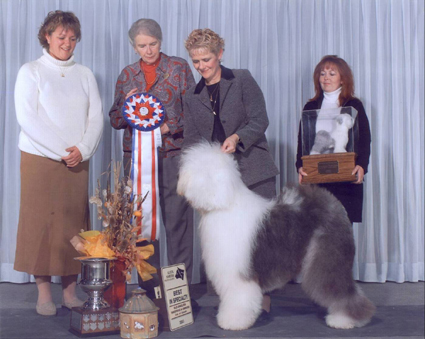CANADIAN
OLD ENGLISH SHEEPDOG
BREED STANDARD

General Appearance
A strong, compact-looking dog of great symmetry, practically the same in measurement from shoulder to stern as in height, absolutely free from legginess or weaselness, very elastic in his gallop, but in walking or trotting he has a characteristic ambling or pacing movement, and his bark should be loud, with a peculiar “pot-casse” ring in it. Taking him all round, he is profusely, but not excessively coated, thick-set muscular, able-bodied dog with a most intelligent expression, free from all Poodle or Deerhound character. Soundness should be considered of greatest importance.
Size
Twenty-two inches (56 cm) and upwards for dogs and slightly less for bitches. Type, character, and symmetry are of the greatest importance and are on no account to be sacrificed to size alone.
Coat and Colour
Coat profuse, but not so excessive as to give the impression of the dog being over fat, and of a good hard texture, not straight, but shaggy and free from curl. Quality and texture of coat to be considered above mere profuseness. Softness or flatness of coat to be considered a fault. The undercoat should be a waterproof pile, when not removed by grooming or season. Colour any shade of grey, grizzle, blue or blue-merled with or without white marking or in reverse. Any shade of brown or fawn to be considered distinctly objectionable and not to be encouraged.
Head
Skull: Capacious and rather squarely formed, giving plenty of room for brain power. The parts of the eyes should be well arched and the whole well covered with hair. Muzzle: Fairly long, strong, square and truncated. The stop should be well defined to avoid a Deerhound face. (The attention of judges is particularly called to the above properties, as a long, narrow head is a deformity). Nose: Always black, large and capacious. Mouth: Teeth strong and large, evenly placed and level in opposition. Eyes vary according to the colour of the dog. Very dark preferred, but in the glaucous or blue dogs a pearl, walleye, or china eye is considered typical. (A light eye is most objectionable). Ears: Medium sized, and carried flat to side of head, coated moderately.
Neck
The neck should be fairly long, arched gracefully and well coated with hair.
Forequarters
The shoulders sloping and narrow at the points. The forelegs should be dead straight, with plenty of bone, removing the body a medium height from the ground, without approaching legginess, and well coated all around.
Body
The dog stands lower at the shoulder than at the loin. Rather short and very compact, ribs well sprung and brisket deep and capacious. Slab-sidedness highly undesirable. The loin should be very stout and gently arched.
Hindquarters
Should be round and muscular with well-let-down hocks, and the hams densely coated with a thick, long jacket in excess of any other part. Feet small, round, toes well arched, and pads thick and hard.
Tail
It is preferable that there should be done. Should never, however, exceed 1-1/2 inches (4-5 cm) in grown dogs. When not natural-born bobtails, puppies should be docked at the first joint from the body and the operation performed when they are from three to four days old.
Faults
Softness or flatness of coat to be considered a fault. Any shade of brown or fawn to be considered distinctly objectionable and not to be encouraged. A long, narrow head is a deformity. A light eye is most objectionable. Slab-sidedness highly undesirable.
Scale of Points
Skull 5
Eyes 5
Ears 5
Teeth 5
Nose 5
Jaw 5
Foreface 5
Neck and shoulders 5
Body and loins 10
Hindquarters 10
Legs 10
Coat (texture, quality and condition) 15
General appearance and movement 15
Total 100
American Standard
FCI Standard